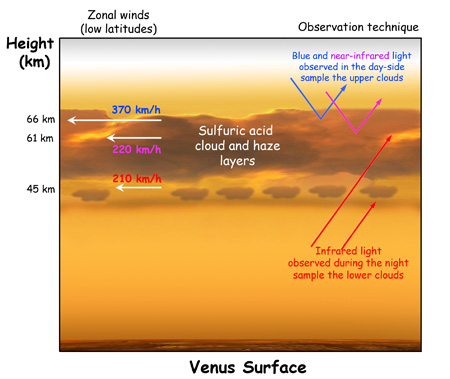The second planet in our Solar System is Venus.
Often called
Earth's twin, the properties of Venus
are far from. While the
density and radius are
similar to
Earth as is the presence of an
atmosphere, the atmosphere properties and rotation
are very different.Like
Mercury, Venus does not
have a satellite moon (and
Mercury and Venus are the
only two planets of our Solar System that do not
have any moons).
Some features of Venus:
- High levels of carbon dioxide result in a
"runaway" greenhouse effect, trapping solar
radiation resulting in very high
temperatures
- 243 day retrograde rotation - its rotates
very slow and backwards
- Extremely high atmospheric winds - 360 km/h - yet mild breeze near the surface
- Hurricane sized vortexes at the poles with double-vortex at the south pole
- Upper atmosphere sulfuric acid clouds
prevent views to surface - infrared camera allow some view
- Lower atmosphere mostly clear, cloud cover ends 45 km from the surface
- Sulfuric acid rain
- Atmospheric pressure 90 times that of
Earth
- Extreme
temperature makes the idea of water
not possible
Venus - A Quick Summary: (More detail here: Venus Fact Sheet)
Back to Top
It's common knowledge that the atmosphere of Venus is poisonous to us. Venus Express has been studying the atmosphere for many months and has refined the atmosphere model:

The surface of Venus has only
been photographed by the Venera probes.

The image above is from Venera 13. The probe
survived for only 2 hours before being crushed by
intense pressure and burned by sulfuric acid.
Other views of the surface - as shown by the
second and third image above - is possible by radar.
While no evidence of tectonic activity exists today,
the lack of impact craters on the surface indicates
that activity did occur but not for very long.
Other surface features:
- 60% rolling planes
- 4% highlands
- 16% volcanic peaks (shield volcanoes)
- Southern hemisphere shows evidence of
cratering
- Northern hemisphere shows no evidence of
cratering
There are many unanswered questions regarding
Venus. Careful study of the atmosphere can
perhaps teach us a lesson in our own atmosphere.
Additionally, the process of volcanism and the
presence of lava flows remains an area of
continual study.
Back
to Top |

